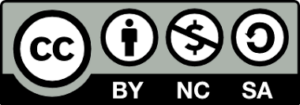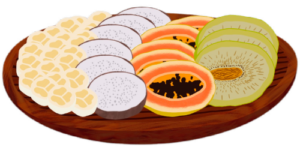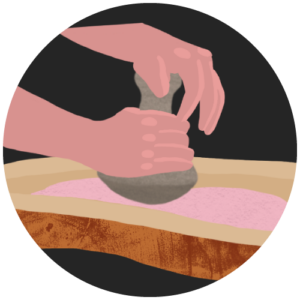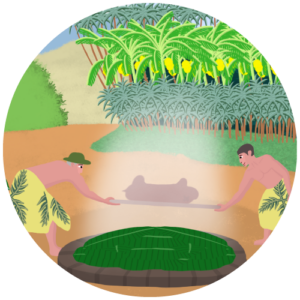Overview/Purpose
ʻIke ʻAi, the deep, experiential knowledge of food and eating, is foundational to life in Hawaiʻi. Our ancestors in Hawaiʻi and across the world developed skills and practices that governed how they selected, grew, prepared, and enjoyed food in a way that sustained individual, community, and environmental health. In our modern context, this type of knowledge is commonly referred to as food literacy.
While many excellent resources on food literacy and food systems education exist, this toolkit highlights content specific to Hawaiʻi and showcases the foods, agricultural traditions, cooking methods, gathering practices, values, etc. that influence what the people of Hawaiʻi love to eat.
Designed for classroom teachers and other community-based educators, this toolkit contains lessons, unit plans, and other resources to facilitate hands-on, engaging food education experiences for students, Pre-K through post-secondary!
The ʻIke ʻAi toolkit is connected to the work led by Dr. Albie Miles, UHWO Sustainable Community Food Systems.
Terms of Use

- Published under Creative Commons Attribution-NonCommercial-ShareAlike 4.0 International (CC BY-NC-SA 4.0)
- Full License
- Under this license, you are free to share (copy and redistribute) and adapt (remix, transform, build upon) the material in this toolkit following these terms:
- Attribution– you must give appropriate credit (cite resource name, author and date accessed), a link to the license, and indicate if changes were made. This may be done in any reasonable manner but not in a way which suggests you are endorsed by toolkit creators.
- NonCommercial– material may not be used for commercial purposes.
- ShareAlike– if you remix, transform or build upon the material you must distribute under the same license (CC BY-NC-SA
- No additional restrictions– you may not apply legal terms or measures which prevent others from doing anything the license permits.
ʻIke ʻAi Food Literacy Toolkit & Nā Hopena Aʻo
All of the Nā Hopena Aʻo (HĀ) Outcomes can be found woven throughout the ʻIke ʻAi Food Literacy Toolkit. We intentionally chose not to align outcomes to specific resources and lessons, as HĀ is a comprehensive framework in which all six outcomes are interdependent.
The resources in this toolkit are Hawaiʻi-specific, and support teachers with integrating culture-based, and place-based education across all core subject areas using food literacy as the entry point, which helps students strengthen their sense of HĀ – Belonging, Responsibility, Excellence, Aloha, Total Well-Being and Hawaiʻi. These lessons and resources encourage students to examine the role of history, culture, and geography local food systems and how they can take action to promote equitable food access for their communities. They also drive home the idea that the environment, food, and people are interconnected and form interdependent relationships.
ʻIke ʻAi Food Literacy Toolkit Themes
This toolkit’s resources are organized into four themes- Sense of Plate, Foods of Living Islands, ʻAi Pono, and Plate to Platter.
These themes mirror the four themes of the Hawaiʻi School Garden Curriculum Map (HSGCM), but with a slightly different “flavor” that is more focused on the food literacy themes found in Theme 3 Nourishment of the HSGCM, rather than garden-based learning outcomes found throughout the map. As part of this project, Theme 3 Nourishment underwent a metamorphosis to include explicit alignment to the Hawaiʻi C3 Social Studies Standards (HGSSS) and social justice themes.
See our descriptions below to learn more!
Note that although all HĀ outcomes are evident throughout all themes of the ʻIke ʻAi Food Literacy Toolkit, we provide a short description of some of the HĀ outcomes found in each theme below.

Sense of Plate explores the cultural and geographic origins of the foods we eat and how our place and its unique plants, animals, history, and cultural traditions inform our preferred customary flavors and cooking styles.
Connection to HĀ Outcomes
Sense of Aloha
- Developing a global awareness and appreciation of other types of ʻike
- Love for own ʻāina, places, and community
Sample Enduring Understandings from HSGCM Theme 3 Nourishment:
- Recognize that food is place-based and that different regions around the world have distinct tastes, preferences, and access to resources.
- Understand the relationship between the environment, food, and people.

Foods of Living Islands delves into the systems, both historic and current, we use in Hawaiʻi to produce food-including farms, gardens, agroforests, oceans, fishponds, and hunting/gathering practices.
Connection to HĀ outcomes
Sense of Excellence
- Growing food requires students to learn the best methods from ʻike kūpuna, kilo, and trial and error.
- Agriculture and food production require students to learn about the individual gifts that they can contribute and to continue sharpening their skills through practice.
Sample Enduring Understandings from HSGCM Theme 3 Nourishment
- Recognize that growing and eating in season optimizes food production and encourages ecological sustainability.
- Identify, design, and practice techniques that build resilient food systems.

ʻAi Pono investigates the ancestral and current knowledge of both cooking and eating. It expands to our knowledge of nutrition, preparation and preservation methods, how to create flavors, and how to do all of this safely.
Connection to HĀ Outcomes
Sense of Total Well-Being
- Eating for individual and community health
- Making healthy choices and lifestyle are critical for effective functioning of bodies and minds
- Developing health across the three piko- past informing the present to create the best possible legacy for the future
Sample Enduring Understandings from HSGCM Theme 3 Nourishment
- Recognize that foods can promote health and wellness, and that health and wellness look different across cultures and among individuals.
- Use a variety of sources, (e.g, nutrition labels, product packaging, cultural history, food stories, and indigenous knowledge and practices) to shape and inform food preferences.

Plate to Platter examines the impacts of food production and distribution on our communities and the environment, locally and globally. It links how our individual plates contribute to a large platter of the global food system.
Connection to HĀ Outcomes
Sense of Responsibility
- Awareness of the social injustices that affect our local and global communities
- Making thoughtful decisions to purchase produce and other foods wisely by supporting local farms
- Supporting policy decisions in favor of responsible agriculture
- Advocating for education around food security
Sample Enduring Understandings from HSGCM Theme 3 Nourishment
- Understand the ecological impacts of locally-produced crops.
- Recognize that, even though food is a basic human right, not all families and communities have access to sufficient food due to affordability, distribution, production and impacts of climate change.
Sections
Resource Contributors
- Amanda Gagliano
- Andrea Nakata
- Anika Agerlie
- Anne Marie Sager
- Blake McNaughton, Former PRISM Fellow
- Brian Yamagata
- Brianna Craig
- Bryan Silver
- Chelsea Takahashi
- Christina Vien, Kealakehe Elementary
- Dr. Heather Spalding
- Dr. Koh Ming Wei
- FEAST Team (Lori Andersen, Koh Ming Wei, Lauren DeMent, Leandra Keuma, Jonathan Kissida, Amber Ritter, Shannon Seleen, Ashley Acuna, Jacqueline Cramer, Douglas J. High, Jaime Lewis, Ilana Stout)
- Hannah Azouz
- Hawaiʻi ʻUlu Cooperative
- Heʻeia Elementary, Micah Wada
- HIP Agriculture
- Hoʻokuaʻāina
- Holly Rodrigues
- ʻImiloa Astronomy Center
- Jyoti Castillo, PhD
- Karen Nakasone
- Katie Hearl
- Keri Sarbida
- Kupuna A. Napua Barrows
- Lina Mochizuki
- Lono Leslie
- Marie Kainoa Fialkowski Revilla, University of Hawaiʻi at Mānoa
- Owen S. Yamaguchi
- Papahana Kuaola
- Rachel Silverman
- Rebecca Akiona, HIDOE Teacher
- Shauna Yusko
- Springer Kaye
- The Kōkua Hawaiʻi Foundation
- The Pacific American Foundation
- Tiana Kamen-Farm to Keiki
- Weinhouse, LHES
Artist Bios
We would like to honor our student artists who designed the logos and art for this digital toolkit during the Spring of 2022!





